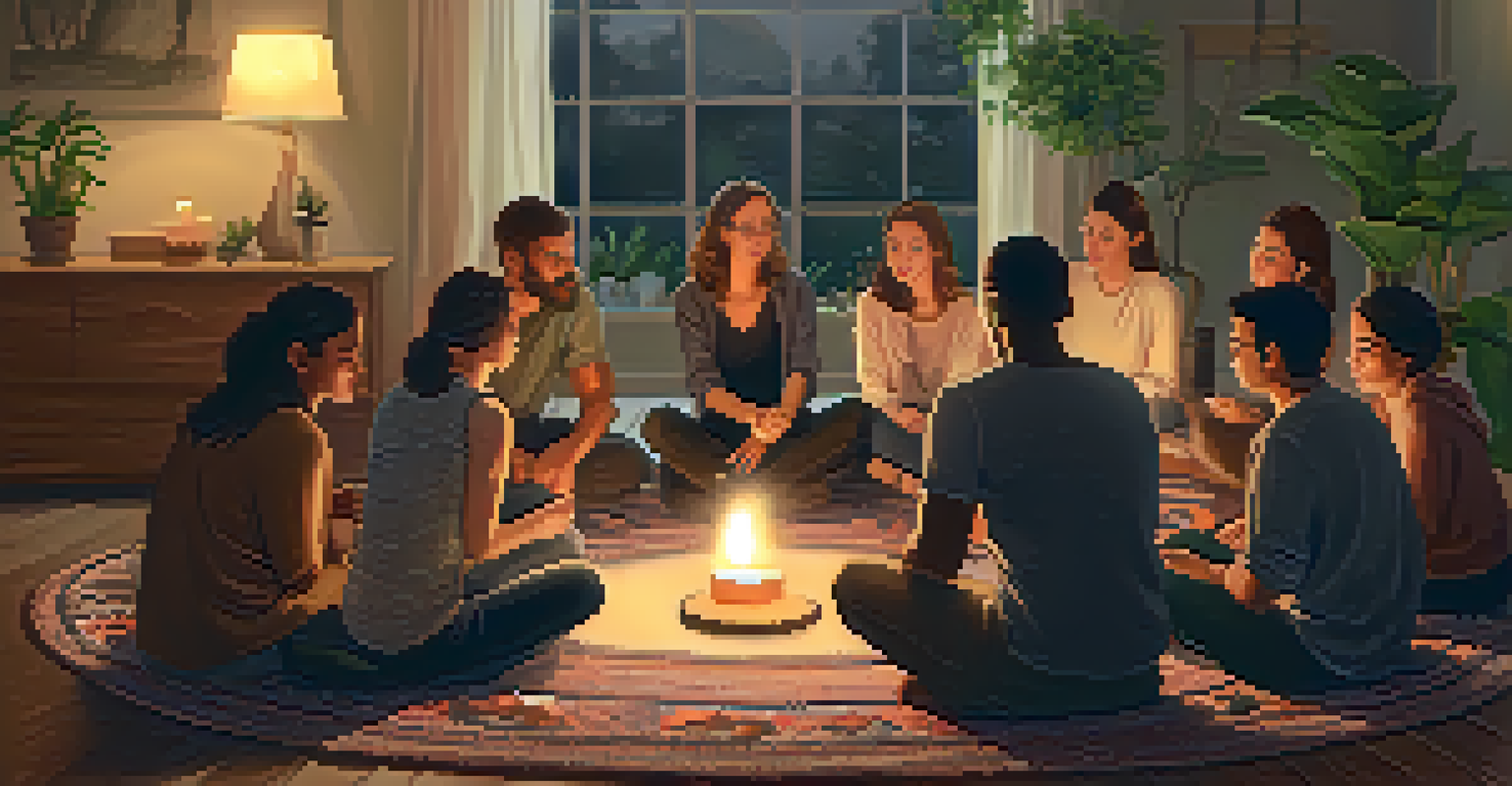The Impact of Set and Setting on Entheogenic Experiences

Understanding Set and Setting in Psychedelics
Set and setting refer to the mindset ('set') and physical environment ('setting') in which a psychedelic experience occurs. These elements play a crucial role in shaping the overall experience with entheogenic substances, like psilocybin or ayahuasca. When individuals engage with these substances, their mental state and surroundings can significantly influence the effects and outcomes of the experience.
The mind is everything. What you think you become.
For instance, someone who approaches an entheogenic ceremony with anxiety or fear may have a vastly different experience than someone who is calm and open-minded. Similarly, a chaotic or uncomfortable setting can lead to feelings of distress, while a serene, supportive environment can foster feelings of peace and connection. This highlights the importance of preparing both mentally and physically before embarking on such a journey.
Ultimately, understanding the concepts of set and setting can empower individuals to create safer and more meaningful psychedelic experiences. By paying attention to these factors, one can navigate their journey with greater awareness and intention, potentially leading to more positive outcomes.
The Role of Mindset in Entheogenic Experiences
Mindset, or 'set', encompasses a person's thoughts, emotions, and expectations going into a psychedelic experience. A positive mindset is often correlated with a more profound, transformative experience. For example, individuals who feel excited and hopeful about their journey are more likely to encounter insights and feelings of interconnectedness compared to those who are apprehensive.

Moreover, pre-existing beliefs about psychedelics can shape the experience. If someone believes that these substances can promote healing or enlightenment, they may be more open to receiving those lessons. Conversely, if they view psychedelics with skepticism or fear, this can create resistance during the experience, potentially leading to challenging moments.
Mindset Shapes Psychedelic Journeys
A positive mindset enhances the potential for deeper insights and transformative experiences during entheogenic journeys.
Thus, cultivating a positive mindset through practices like meditation, affirmations, or even simple relaxation techniques can enhance the overall journey. Preparing mentally not only sets the stage for a better experience but can also help individuals integrate their experiences afterward.
The Importance of Physical Environment
The physical environment, or 'setting', where an entheogenic experience takes place can greatly influence its nature. A tranquil, natural setting, like a forest or a beach, can enhance feelings of connection to nature and promote introspection. In contrast, a loud or cluttered space may lead to distractions and discomfort, detracting from the experience.
Set your intentions and the universe will conspire to make them happen.
Consider the difference between taking psychedelics in a cozy, dimly lit room with soft music versus a noisy bar filled with people. The former can create a safe space for exploration, while the latter may induce anxiety and chaos. This underscores how setting can either facilitate or hinder the depth of one's experience.
Creating an ideal setting often involves considering aspects such as lighting, temperature, and even the presence of trusted companions. Ensuring that the environment is comfortable and conducive to exploration can help individuals feel more at ease, allowing them to dive deeper into their entheogenic journey.
The Influence of Group Dynamics
When participating in entheogenic experiences, the presence of others can significantly affect the journey. Group dynamics play a crucial role in shaping the emotional climate of the experience. A supportive group can foster feelings of safety and connection, while a tense or judgmental group can contribute to anxiety and fear.
For example, when individuals share their experiences in a circle, it can create a sense of community and belonging. This shared vulnerability can lead to deeper insights and healing. On the other hand, if someone feels isolated or judged by others in the group, it may inhibit their ability to fully engage with the experience.
Environment Influences Experience
The physical setting significantly affects the nature of the entheogenic experience, with supportive environments fostering exploration.
Thus, choosing the right company for an entheogenic journey is important. Surrounding oneself with empathetic, understanding individuals can enhance the overall experience and promote positive interactions during and after the journey.
Setting Intentions for Entheogenic Experiences
Setting intentions is a powerful practice that can guide an entheogenic experience. An intention serves as a focal point, helping individuals navigate their journey with purpose. For instance, someone might set an intention to explore self-love or to process grief, which can provide clarity during the experience.
When individuals approach their journey with a clear intention, they are often more likely to encounter relevant insights. It acts as a compass, directing attention toward specific emotions or experiences that may need exploration. This can lead to more meaningful interactions with the entheogenic substance.
Additionally, taking time to reflect on one's intention before the experience can enhance the overall journey. This practice not only helps in clarifying what one hopes to gain but also sets a positive tone for the experience ahead.
Post-Experience Reflection and Integration
Post-experience reflection and integration are vital components of the entheogenic journey. After the experience, taking time to process what was encountered can help solidify insights and lessons learned. Journaling, discussing with trusted friends, or even engaging in therapy can aid in this process.
Integration involves making sense of the experience and finding ways to incorporate insights into daily life. This might include adopting new perspectives, changing habits, or deepening spiritual practices. Without integration, valuable insights may fade away, leaving individuals feeling disconnected from the experience.
Integration is Key for Growth
Post-experience reflection and integration are essential for turning psychedelic insights into lasting personal development.
Therefore, creating a plan for integration following an entheogenic journey can enhance its long-term benefits. By prioritizing reflection and integrating lessons learned, individuals can transform their experiences into lasting personal growth.
Cultural Contexts and Entheogenic Practices
Cultural context plays a significant role in shaping the understanding and use of entheogens. Many indigenous cultures have long used entheogenic substances in sacred rituals, viewing them as tools for healing, connection, and spiritual exploration. The cultural framework provides a supportive environment that amplifies the power of these substances.
In contrast, modern Western contexts often lack this cultural grounding, which can lead to misunderstandings or misuse of entheogens. Without a framework, individuals may approach these substances recreationally, missing out on the deeper, more transformative potential they can offer. This highlights the importance of respecting and learning from traditional practices.

By acknowledging and understanding the cultural contexts surrounding entheogens, we can foster a more respectful approach to their use. Engaging with these substances mindfully, while respecting their historical significance, can lead to more meaningful and enriching experiences.